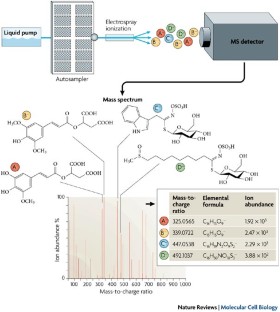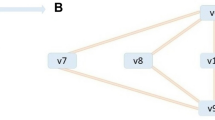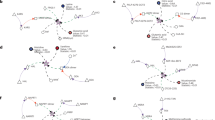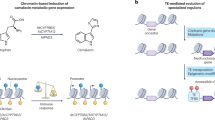Abstract
Methods for network-wide analysis are increasingly showing that the textbook view of the regulation of plant metabolism is often incomplete and misleading. Recent innovations in small-molecule analysis have created the ability to rapidly identify and quantify numerous compounds, and these data are creating new opportunities for understanding plant metabolism and for plant metabolic engineering.
This is a preview of subscription content, access via your institution
Access options
Subscribe to this journal
Receive 12 print issues and online access
$189.00 per year
only $15.75 per issue
Buy this article
- Purchase on Springer Link
- Instant access to full article PDF
Prices may be subject to local taxes which are calculated during checkout




Similar content being viewed by others
References
Fiehn, O. Metabolomics — the link between genotypes and phenotypes. Plant Mol. Biol. 48, 155–171 (2002).
Dunn, W. B. & Ellis, D. I. Metabolomics: current analytical platforms and methodologies. Trends Anal. Chem. 24, 285–294 (2005).
Sweetlove, L. J., Last, R. L. & Fernie, A. R. Predictive metabolic engineering: a goal for systems biology. Plant Physiol. 132, 420–425 (2003).
Ward, J. L., Harris, C., Lewis, J. & Beale, M. H. Assessment of 1H NMR spectroscopy and multivariate analysis as a technique for metabolite fingerprinting of Arabidopsis thaliana. Phytochemistry 62, 949–957 (2003).
Krishnan, P., Kruger, N. J. & Ratcliffe, R. G. Metabolite fingerprinting and profiling in plants using NMR. J. Exp. Bot. 56, 255–265 (2005).
Ratcliffe, R. G. & Shachar-Hill, Y. Probing plant metabolism with NMR. Annu. Rev. Plant Physiol. Plant Mol. Biol. 52, 499–526 (2001).
Ratcliffe, R. G., Roscher, A. & Shachar-Hill, Y. Plant NMR spectroscopy. Prog. Nucl. Magn. Reson. Spectros. 39, 267–300 (2001).
Glinski, M. & Weckwerth, W. The role of mass spectrometry in plant systems biology. Mass Spectrom. Rev. 25, 173–214 (2006).
Villas-Bôas, S. G., Mas, S., Åkesson, M., Smedsgaard, J. & Nielsen, J. Mass spectrometry in metabolome analysis. Mass Spectrom. Rev. 24, 613–646 (2005).
Aharoni, A. et al. Nontargeted metabolome analysis by use of fourier transform ion cyclotron mass spectrometry. OMICS 6, 217–234 (2002).
Tohge, T. et al. Functional genomics by integrated analysis of metabolome and transcriptome of Arabidopsis plants over-expressing an MYB transcription factor. Plant J. 42, 218–235 (2005).
Catchpole, G. S. et al. Hierarchical metabolomics demonstrates substantial compositional similarity between genetically modified and conventional potato crops. Proc. Natl Acad. Sci. USA 102, 14458–14462 (2005).
Hu, Q. et al. The Orbitrap: a new mass spectrometer. J. Mass. Spectrom. 40, 430–443 (2005).
Weckwerth, W., Loureiro, M. E., Wenzel, K. & Fiehn, O. Differential metabolic networks unravel the effects of silent plant phenotypes. Proc. Natl Acad. Sci. USA 101, 7809–7814 (2004).
Ratcliffe, R. G. & Shachar-Hill, Y. Revealing metabolic phenotypes in plants: inputs from NMR analysis. Biol. Rev. 80, 27–43 (2005).
Janes, K. A. & Yaffe, M. B. Data-driven modelling of signal-transduction networks. Nature Rev. Mol. Cell Biol. 7, 820–828 (2006).
Fan, T. W. M. et al. Comprehensive chemical profiling of gramineous plant root exudates using high-resolution NMR and MS. Phytochemistry 57, 209–221 (2001).
Shachar-Hill, Y. & Pfeffer, P. Nuclear Magnetic Resonance in Plant Biology (American Society of Plant Biologists, Rockville, 1996).
Bailey, N. J., Stanley, P. D., Hadfield, S. T., Lindon, J. C. & Nicholson, J. K. Mass spectrometrically detected directly coupled high performance liquid chromatography/nuclear magnetic resonance spectroscopy/mass spectrometry for the identification of xenobiotic metabolites in maize plants. Rapid Commun. Mass Spectrom. 14, 679–684 (2000).
Fan, T. W. M., Higashi, R. M., Lane, A. N. & Jardetzky, O. Combined use of 1H-NMR and GC–MS for metabolite monitoring and in vivo1H-NMR assignments. Biochim. Biophys. Acta 882, 154–167 (1986).
Morgenthal, K., Weckwerth, W. & Steuer, R. Metabolic networks in plants: transitions from pattern recognition to biological interpretation. BioSystems 83, 108–117 (2006).
Pettersson, G. & Ryde-Pettersson, U. A mathematical model of the Calvin photosynthesis cycle. Eur. J. Biochem. 175, 661–672 (1988).
Tikunov, Y. et al. A novel approach for nontargeted data analysis for metabolomics. Large-scale profiling of tomato fruit volatiles. Plant Physiol. 139, 1125–1137 (2005).
Broeckling, C. D., Reddy, I. R., Duran, A. L., Zhao, X. & Sumner, L. W. MET-IDEA: data extraction tool for mass spectrometry-based metabolomics. Anal. Chem. 78, 4334–4341 (2006).
Jonsson, P. et al. High-throughput data analysis for detecting and identifying differences between samples in GC–MS-based metabolomic analyses. Anal. Chem. 77, 5635–5642 (2005).
Scholz, M., Gatzek, S., Sterling, A., Fiehn, O. & Selbig, J. Metabolite fingerprinting: detecting biological features by independent component analysis. Bioinformatics 20, 2447–2454 (2004).
Goodacre, R., York, E. V., Heald, J. K. & Scott, I. M. Chemometric discrimination of unfractionated plant extracts analyzed by electrospray mass spectrometry. Phytochemistry 62, 859–863 (2003).
Hirai, M. Y. et al. Integration of transcriptomics and metabolomics for understanding of global responses to nutritional stresses in Arabidopsis thaliana. Proc. Natl Acad. Sci. USA 101, 10205–10210 (2004).
Wurtele, E. S. et al. MetNet: software to build and model the biogenetic lattice of Arabidopsis. Comp. Funct. Genomics 4, 239–245 (2003).
Thimm, O. et al. MAPMAN: a user-driven tool to display genomics data sets onto diagrams of metabolic pathways and other biological processes. Plant J. 37, 914–939 (2004).
Zimmermann, P., Hirsch-Hoffmann, M., Hennig, L. & Gruissem, W. GENEVESTIGATOR. Arabidopsis microarray database and analysis toolbox. Plant Physiol. 136, 2621–2632 (2004).
Cook, D., Fowler, S., Fiehn, O. & Thomashow, M. F. A prominent role for the CBF cold response pathway in configuring the low-temperature metabolome of Arabidopsis. Proc. Natl Acad. Sci. USA 101, 15243–15248 (2004).
Van Eenennaam, A. L. et al. Engineering vitamin E content: from Arabidopsis mutant to soy oil. Plant Cell 15, 3007–3019 (2003).
Charlton, A. et al. NMR profiling of transgenic peas. Plant Biotech. J. 2, 27–35 (2004).
Le Gall, G., Colquhoun, I. J. & Defernez, M. Metabolite profiling using 1H NMR spectroscopy for quality assessment of green tea, Camellia sinensis (L.). J. Agric. Food Chem. 52, 692–700 (2004).
Noteborn, H. P., Lommen, A., van der Jagt, R. C. & Weseman, J. M. Chemical fingerprinting for the evaluation of unintended secondary metabolic changes in transgenic food crops. J. Biotechnol. 77, 103–114 (2000).
Manetti, C. et al. A metabonomic study of transgenic maize (Zea mays) seeds revealed variations in osmolytes and branched amino acids. J. Exp. Bot. 57, 2613–2625 (2006).
Benning, C. Genetic mutant screening by direct metabolite analysis. Anal. Biochem. 332, 1–9 (2004).
Rose, A. B., Li, J. & Last, R. L. An allelic series of blue fluorescent trp1 mutants of Arabidopsis thaliana. Genetics 145, 197–205 (1997).
Winkel-Shirley, B. Flavonoid biosynthesis. A colorful model for genetics, biochemistry, cell biology, and biotechnology. Plant Physiol. 126, 485–493 (2001).
Chapple, C. C., Vogt, T., Ellis, B. E. & Somerville, C. R. An Arabidopsis mutant defective in the general phenylpropanoid pathway. Plant Cell 4, 1413–1424 (1992).
Somerville, C. & Browse, J. Plant lipids: metabolism, mutants and membranes. Science 252, 80–87 (1991).
Cheng, Z. et al. Highly divergent methyltransferases catalyze a conserved reaction in tocopherol and plastoquinone synthesis in cyanobacteria and photosynthetic eukaryotes. Plant Cell 15, 2343–2356 (2003).
Valentin, H. E. et al. The Arabidopsis vitamin E pathway gene 5–1 mutant reveals a critical role for phytol kinase in seed tocopherol biosynthesis. Plant Cell 18, 212–224 (2006).
Conklin, P. L., Saracco, S. A., Norris, S. R. & Last, R. L. Identification of ascorbic acid-deficient Arabidopsis thaliana mutants. Genetics 154, 847–856 (2000).
Jander, G. et al. Application of a high-throughput HPLC–MS/MS assay to Arabidopsis mutant screening; evidence that threonine aldolase plays a role in seed nutritional quality. Plant J. 39, 465–475 (2004).
Broeckling, C. D. et al. Metabolic profiling of Medicago truncatula cell cultures reveals the effects of biotic and abiotic elicitors on metabolism. J. Exp. Bot. 56, 323–336 (2005).
Schauer, N. et al. Comprehensive metabolic profiling and phenotyping of interspecific introgression lines for tomato improvement. Nature Biotechnol. 24, 447–454 (2006).
Eshed, Y. & Zamir, D. An introgression line population of Lycopersicon pennellii in the cultivated tomato enables the identification and fine mapping of yield-associated QTL. Genetics 141, 1147–1162 (1995).
Keurentjes, J. J. et al. The genetics of plant metabolism. Nature Genet. 38, 842–849 (2006).
Fell, D. A. Enzymes, metabolites and fluxes. J. Exp. Bot. 56, 267–272 (2005).
Tomos, A. D. & Leigh, R. A. The pressure probe: a versatile tool in plant cell physiology. Annu. Rev. Plant Physiol. Plant Mol. Biol. 50, 447–472 (1999).
Lalonde, S., Ehrhardt, D. W. & Frommer, W. B. Shining light on signaling and metabolic networks by genetically encoded biosensors. Curr. Opin. Plant Biol. 8, 574–581 (2005).
Ratcliffe, R. G. & Shachar-Hill, Y. Measuring multiple fluxes through plant metabolic networks. Plant J. 45, 490–511 (2006).
Raamsdonk, L. M. et al. A functional genomics strategy that uses metabolome data to reveal the phenotype of silent mutations. Nature Biotechnol. 19, 45–50 (2001).
Acknowledgements
Research in the Jones, Last and Shachar-Hill laboratories is funded by grants from the National Science Foundation, United States Department of Agriculture Competitive Grants Program, the National Institutes of Health and Michigan State University.
Author information
Authors and Affiliations
Corresponding author
Ethics declarations
Competing interests
The authors declare no competing financial interests.
Supplementary information
Supplementary information S1 (box)
Statistical methods used in the analysis of metabolomics data. (PDF 594 kb)
Related links
Related links
FURTHER INFORMATION
AraCyc Arabidopsis metabolic pathway annotations
L. penellii Introgression Lines
Metabolic Ontology Working Group
MetAlign tool for GC– or LC–MS data analysis
Solcyc Solanaceae metabolic pathway annotations
WTEC Panel Report on International Research and Development in Systems Biology
Glossary
- Allelopathic
-
The known or postulated ability of a plant-produced chemical to modify the physiology of a nearby plant, which constitutes a form of chemical communication between plants.
- Capillary electrophoresis
-
Separation of compounds by the different times that they take to traverse a narrow column under the influence of an electric field.
- Electrospray ionization
-
(ESI). A gentle method for ionizing compounds that applies high voltage to a solution of compounds that are sprayed through a capillary.
- Flavonoid family
-
A large family of structurally diverse molecules that are produced by plants. They confer common colours to leaves, flowers and fruits, absorb ultraviolet light and have other known and postulated roles in plant growth and development.
- Flow-injection analysis
-
(FIA). Introduction of a sample into a flowing medium that transports the sample components to a detector, such as a mass spectrometer, without chromatographic separation.
- Fourier-transform-infrared (FT-IR) spectroscopy
-
Spectroscopy that enables the identification of classes of compound by analysing their interactions with infrared light. Mass resolution is the ability to distinguish ions of different masses, usually expressed as a ratio of the ion mass to the difference in mass that the mass spectrometer can reliably distinguish.
- Fourier-transform ion cyclotron resonance (FT-ICR) mass spectrometry
-
A method for obtaining accurate measurements of the mass-to-charge ratio of ions in a complex mixture, allowing the identification and measurement of the molecules.
- Freezing-tolerance response
-
A measure of the ability of an organism to survive when exposed to below-freezing temperatures.
- Gas chromatography
-
(GC). Method for the separation of volatile compounds in a gas phase through differential binding to a column at elevated temperatures.
- High-performance liquid chromatography
-
(HPLC). Method for separating compounds in solution through their differential interactions with a column.
- HPLC with electrochemical or photodiode-array detection
-
Method for the separation of metabolites by HPLC followed by the detection of the metabolites based on their redox behaviour or spectral absorption properties.
- Mass-to-charge ratio
-
(m/z). The ratio of the mass of an ion (in Daltons, or atomic mass units) to the number of charges on the ion.
- Nominal mass
-
The mass of a molecule, rounded off to the nearest integer value. Two compounds with different elemental formulas can have identical nominal masses, although their exact masses might differ by a small fraction of a Dalton (or atomic mass unit).
- Orbitrap mass analyser
-
A high-resolution mass spectrometer that traps ions in an electric field and measures their abundances and mass-to-charge ratios based on their orbital motions in the ion trap.
- Targeted metabolite analysis
-
Quantitative analysis of a pre-selected list of metabolites.
- Thin-layer chromatography
-
Method for the separation of molecules through their differential interactions with a matrix on a glass or plastic plate.
Rights and permissions
About this article
Cite this article
Last, R., Jones, A. & Shachar-Hill, Y. Towards the plant metabolome and beyond. Nat Rev Mol Cell Biol 8, 167–174 (2007). https://doi.org/10.1038/nrm2098
Published:
Issue Date:
DOI: https://doi.org/10.1038/nrm2098
This article is cited by
-
Metabolomics: a systems biology approach for enhancing heat stress tolerance in plants
Plant Cell Reports (2022)
-
Infrastructures of systems biology that facilitate functional genomic study in rice
Rice (2019)
-
β-Aminobutyric acid increases drought tolerance and reorganizes solute content and water homeostasis in flax (Linum usitatissimum)
Metabolomics (2015)
-
Computational mass spectrometry for small molecules
Journal of Cheminformatics (2013)
-
Physiological and metabolomic analysis of a knockout mutant suggests a critical role of MtP5CS3 gene in osmotic stress tolerance of Medicago truncatula
Euphytica (2013)



